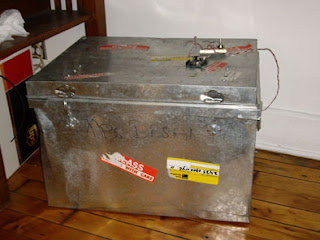Thursday, October 25, 2007
Hiding sensors
We tried to hide sensors people not to fine them easily.
But here, I open the secret!
This one is for a bag.

This one is for a book.

This one is for pencils.

This one is for a cup.

And we hided a sensor for a box in the book.


Midterm | a cup
Midterm | a tissue box
Inside of the box

The computer fan


Midterm | a box

Midterm | pencils
Initially when I attached motors to the pencils,I used regular wires, but these presented a big obstacle in the way og vibrating the pencils. So we borrowed tiny wires from Tim and it helped to make the pencils move.



Midterm | a bag
Our second object was a bag. We were trying to make bag turn and move like a mouse. Chris built a base box to hide one servo. And he put the other servo in the bag. Also to close the mouse of the bag, he used a rubber band. This process was more complicated than we expected. But finally we could get a satisfied movement form the bag.

Inside the bag


Under the bag ( inside the box)

Midterm | a book
Initially, we wanted to make a book talk!
We used one servo motor open and close a fake book.
This book was from Chris. We tried to use a pot and an IR sensor as an analog input but finally we used a proximity sensor to get analog values. Because a proximity sensor could perceive loger distance and get more exact values than an IR sensor.





Focusing on the movement
Wednesday, October 24, 2007
Developing Ideas
IR sensor
3 ft. - one up and down, random time delay 1.5-3 secs, up and down again
2 ft. - larger up and down random every .5-1 sec
1 ft. - largest up and down random every 20 mili - .2 sec, drunk laugh, after 5 secs of being close it vomits (green LEDs), panting, and passes out
Bag:
ultrasonic sensor
6 ft - giggle
4 ft - move away slightly, giggle more
2 ft - coy , move away totally (125 degrees)
touch/lift - screams! (looking under dress)
Pencils:
IR sensor
3 ft. - small chatter
1.75 ft. - more chatter, sounding like angry or sneaky
.5 ft. - gone crazy, jumping everywhere, loud party
Ideas for a midterm
When we use interactive devices, there are always expected situations and the purposes of interactions. For example, when we use vending machine, the expected situation is that if you put the money, push the button, finally the machine will give you a drink. And the purpose that you start interacting with a machine is to get a drink.
But we thought that there could be different kind of interactivities with objects. If we trigger some interactivities without learned and decided actions and special purposes, we can have new experiences. And the situation that has unexpected interactivities can be very interesting. For instance, trash cans can tremble when we walk beside them, and the reactions of these trash cans can make interactivities with other objects such as papers, boxes, chairs, bags etc. In this situation, we can involve the interactivity or we can observe the unusual interactions among the objects that are installed in an environment.
Finally, we will make a special situation that you can experience unusual interactivities. We will install some devices to make objects react to people or other objects.
**David's first meeting note
Although we have some good ideas that would easily fulfill the requirements of the mid-term project assignment (Chris’ box idea, jug orchestra, etc) we decided it was of greatest value for ourselves and the project to take a more ground-up approach to the construction of the concept and production of the final piece. We described several ideas centered around a universal theme such as social protest, environmental effects and sustainability, economic diversity, and __ - all while considering uses of interactivity for the final “device”. We are all fairly confident in the basic electronics in PComp class and after discussing our individual skill sets (Chris: physical construction/production, EJ: graphic and movement design, David: interface design and development) and found we are all very interested in experimenting with new/different sensors along with passive interaction in an installation environment. The meeting ended with ideas surrounding the creation of several autonomous devices triggered by an unknowing user entering into a space, inadvertently triggering sensors that, in-turn, trigger other devices. The anthropomorphic objects considered were trash cans, lamps, cell phones, boxes, and plants. All objects discussed would be blended into the environment, and the non-technical aspect of the objects would create a much more approachable interaction for the user, causing a very pleasant experience. Although a learning curve would be needed for interaction, this would also be seen as comical and not intimidating.
Options for user and device interaction in environment:
- objects that are having conversation between each other, and user “interrupts” this conversation
- objects lay dormant in their setting until being triggered by the user, which then trigger other devices using other sensor/sensory inputs
- objects in conversation that eventually “ignore” the user
- pre-determined scenes randomly generated
- objects being usable only with a single user
- objects requiring multiple users
- objects laying dormant only when in user(s)’ presence, “acting” when in solidarity
- linear narrative scene(s) between user and object(s)
- non-linear scenes created by device and user interaction





